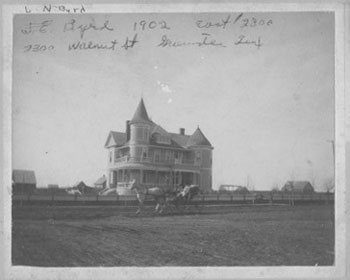
The L.N. Byrd house was located at 2300 Walnut Street when this photo was taken in 1902. Tree planting efforts in 1910 would change this view and today Walnut Street has many beautiful trees shading its sidewalks. (photo from author’s collection)
When the first settlers arrived North Texas, they found what they called “thickets” throughout the prairies, tree-lined banks along small creeks and even smaller branches. Timber was a necessity for settlement. It was used for building and fuel. By the 1850s the landowners began clearing their fields to grow cotton. By 1900, trees in the area were virtually gone.
On Saturday, February 5, 1910 the Greenville Evening Banner ran an article written by Hubert Harrison, the son of a prominent real estate man. Harrison, himself a civic promoter, reminded citizens of Greenville that newcomers were interested in moving to Greenville and that the physical surroundings had great influence on the feeling and lives of residents and prospective residents.
Residents were admonished to keep dirt streets clean of trash, as well as vacant lots. Some cities and towns had streets lined with magnificent trees in neat curbs. “So why not Greenville?” Harrison asked.
Citizens were asked to clean up trash, plant trees and flowers, and beautify the town. In fact, Harrison wrote that nothing adds more to a town than trees, and as this was written in early February, tree-planting season was rapidly passing. A
Civic Improvement Committee called for a grand tree-planting festival to last five days, beginning February 1 and ending the day the article was published. That was to be Tree Day in Greenville.
Everyone was to plant at least one tree during the week, more if possible. To instill a deeper interest in the tree-planting activity, prizes were offered. For the person who planted the largest number of trees during the five days would receive $10.00 ($267.00 today). But the big winner received a cash prize of $50 ($1,335 today). The Civic Improvement Committee, of which Harrison was chairman, would bestow the $50 prize to the homeowner who made the greatest noticeable improvement before September 1.
Unfortunately I don’t know the winners, but I have seen photographs of homes about five years later with spectacular flower gardens. Fragrant rose bushes surrounded Dr. Joe Becton’s home on O’Neal and Johnson Streets.
I live in a section of town that became part of Greenville in the 1970s. We have over seventy-five trees; oaks, cedars, and cedar elms that I treasure. They are gorgeous year round, except for this week when the pollen blows a gale. If I leave my black car on the driveway, it will be yellow tomorrow. But that’s a small price to pay for beautiful trees, birds, and even pesky squirrels.
